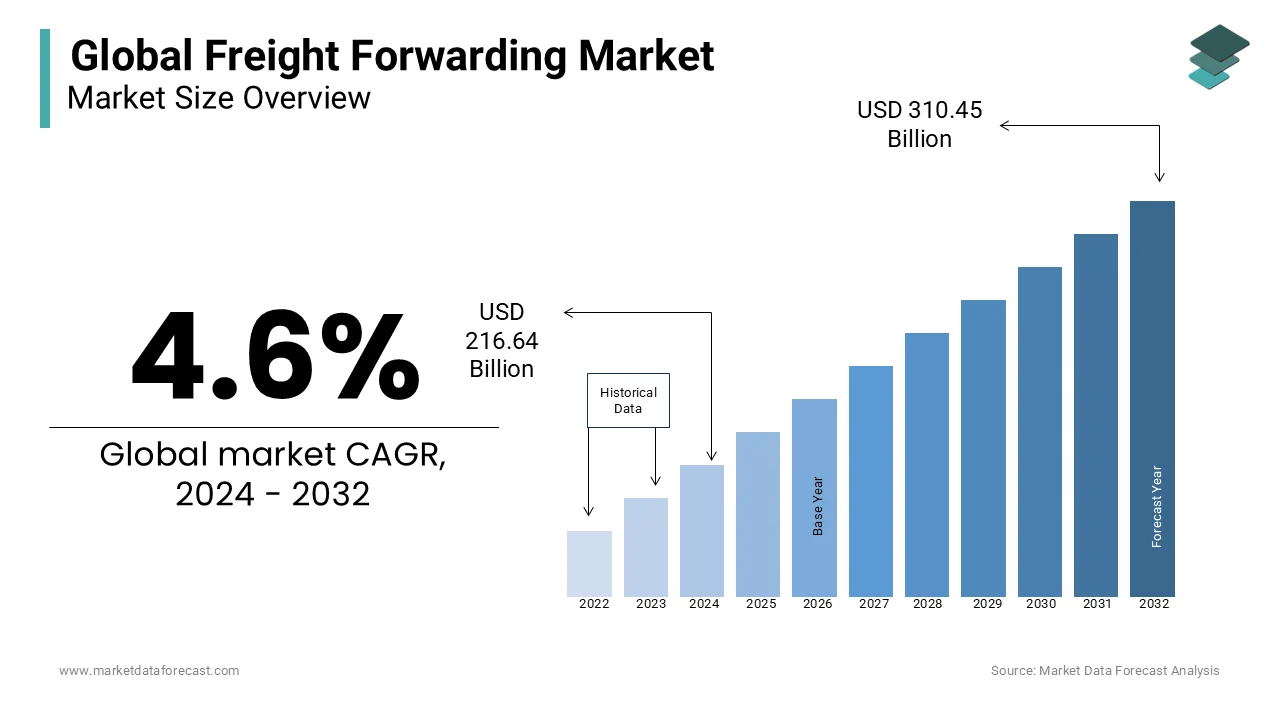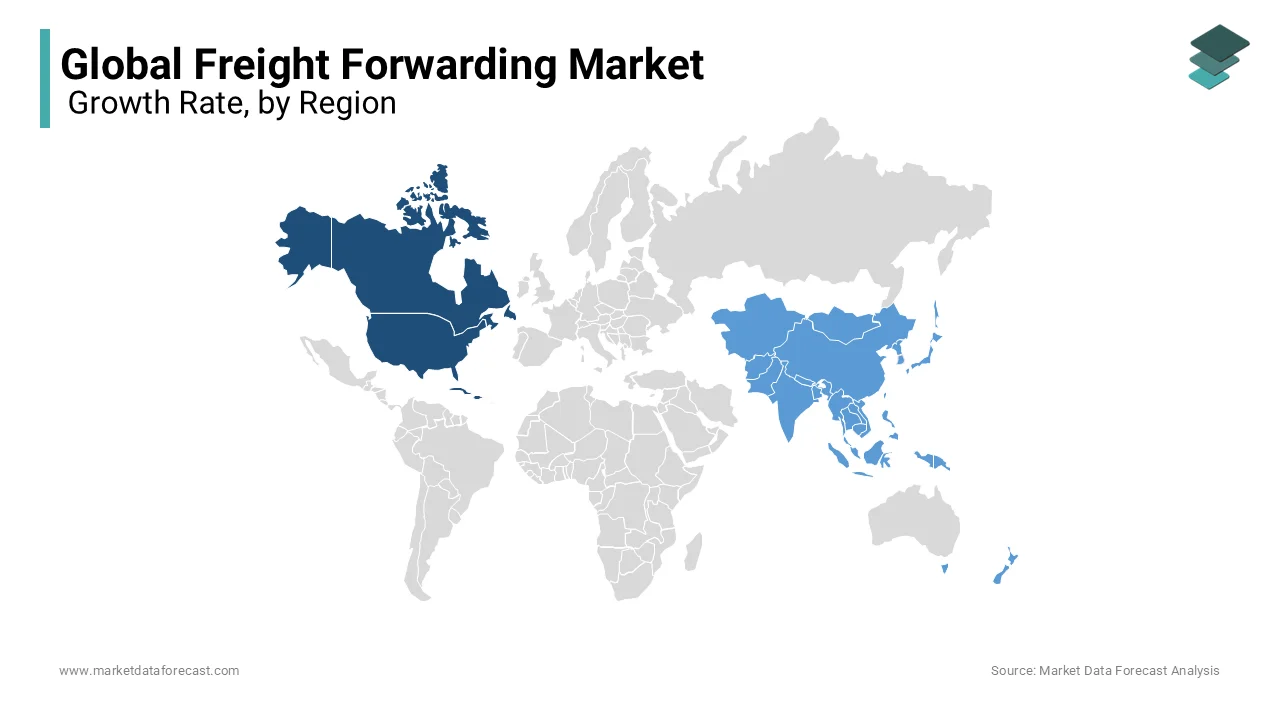Global Freight Forwarding Market Size, Share, Trends, & Growth Forecast Report – Segmented by Type (Sea Freight Forwarding, Air Freight Forwarding, Road Freight Forwarding, and Rail Freight Forwarding), Service (Documentation, Packaging, VAS, and Transportation & Warehousing), Shipping Mode (Aircraft, Trucks, Ships, and Railroads) & Region - Industry Forecast From 2024 to 2032
Global Freight Forwarding Market Size (2024 to 2032)
The global freight forwarding market was worth USD 207.11 billion in 2023. The global market is predicted to reach USD 216.64 billion in 2024 and USD 310.45 billion by 2032, growing at a CAGR of 4.6% during the forecast period.

Freight forwarders, also known as non-ship-operated general carriers, are agents who organize shipments for the industry from the manufacturer to their final destination. Freight forwarders enter into contracts with carriers to transport cargo. This allows us to offer a secure cargo movement network at an affordable price. They act as supply chain experts, including commercial invoices, warehousing, packaging, documentation, shipper's export declarations, and distribution to final destinations. Freight forwarding can be defined as an integrated service provided by various logistics and transportation companies, and these organizations prepare to transport cargo safely from one place to another. Freight transportation is carried out by intermediate representative printing agents. It constitutes the economical, safe, and efficient transport and storage of goods in a number of industries, especially from manufacturers to end users or final distribution locations. Freight forwarders have ongoing contracts with airlines, carriers, rail and road operators for the transportation of goods. The increase in the volume of international trade is an important factor in the global Freight Forwarding market. In addition, the increase in trade agreements between countries is contributing to the business's growth.
MARKET DRIVERS
A key factor driving the Freight Forwarding market growth is the high demand for low-cost deliveries and the ability to identify customer requirements and respond quickly with logistics solutions.
Trends such as high demand for integrated services further drive the global Freight Forwarding market growth. In general, freight forwarders provide customers with a variety of integrated services. This includes the usual freight forwarder from origin to destination, as well as many other services. In addition, the increase in trade agreements between countries helps increase the Freight Forwarding market growth. The increase in the volume of international trade is one of the main drivers of the growth of the Freight Forwarding market. Also, the burgeoning e-commerce market has fueled the growth of the freight forwarding market by expanding business activity. In particular, the increase in trade agreements between emerging economies is a key factor driving the Freight Forwarding market growth of international trade. Increasing transportation demand in the perishable food and life science / medical sectors is expected to drive the Freight Forwarding market growth over the forecast period. While the elimination of brokerage, especially from cloud-based services, is impossible, the technology is supposed to become increasingly popular with freight forwarders operating around the world, who are foreseen to lead the global Freight Forwarding market.
Additionally, mergers and acquisitions in the global Freight Forwarding industry have hampered ocean and air cargo locations. The key factors driving the growth in the size of the global freight forwarding market are the increasing demand for low-cost deliveries, the ability to be aware of consumer requirements, and the rapid response to logistics solutions. The growing demand for integrated services will also drive the Freight Forwarding market growth. Besides, the integrated services provided by freight forwarders are another key factor responsible for the growth of the freight forwarder market. In addition to cargo transportation, freight forwarders provide other integrated services such as packaging, insurance, and documentation. Therefore, the availability of a wide range of services has also driven the growth of the Freight Forwarding market. In addition, the cooperative supply chain network, further driven by technology and computer software, is expected to spur the improvement of the entire freight forwarding industry during the forecast period. The growing trend of multimodal freight transportation will further accelerate the Freight Forwarding market growth in the future. Additionally, due to declining global Freight Forwarding market demand, several companies focus on improving profitability rather than increasing product portfolios. This is further established through a focus on technology and software investment, rationalization, and high capital contract opportunities.
MARKET RESTRAINTS
The global freight forwarding market contracted in 2020 for the first time since the global financial crisis. The world economy and trade slowdown have affected the Freight Forwarding industry. The increase in the manufacture of near and coastal rings is hampering the growth of the Freight Forwarding market. The proliferation of offshore ring manufacturing activities globally, which is expected to result in a lack of adoption of commercial activities, is expected to slow the Freight Forwarding market growth.
REPORT COVERAGE
|
REPORT METRIC |
DETAILS |
|
Market Size Available |
2023 to 2032 |
|
Base Year |
2023 |
|
Forecast Period |
2024 to 2032 |
|
CAGR |
4.6% |
|
Segments Covered |
By Type, Service, Shipping Mode, and Region |
|
Various Analyses Covered |
Global, Regional & Country Level Analysis, Segment-Level Analysis, DROC, PESTLE Analysis, Porter’s Five Forces Analysis, Competitive Landscape, Analyst Overview on Investment Opportunities |
|
Regions Covered |
North America, Europe, APAC, Latin America, Middle East & Africa |
|
Market Leaders Profiled |
BDP International, Agility Global Integrated Logistics, CEVA Logistics, Hellmann Worldwide Logistics, C.H. Robinson, DSV, DAMCO, Geodis, Expeditors International, Kerry Logistics, and Others. |
SEGMENTLA ANALYSIS

REGIONAL ANALYSIS

North America Freight Forwarding Market and Europe Freight Forwarding Market are home to the world's leading providers of such services. The global Freight Forwarding industry is going through an uncertain period due to COVID-19. On the other hand, the Asia Pacific region is expected to create lucrative opportunities in the next two years. Increasing industrialization, the growth of emerging economies, and the adoption of online e-commerce portals are foreseen to be some of the key drivers of the growth of the freight forwarding services market.
The Asia Pacific market is one of the few regions that continues to grow despite the pandemic. For the Freight Forwarding markets, Asia Pacific is the fastest growing area in the world. This is due to the increasing logistics of ASEAN countries and the presence of major economies such as China and India. In addition, the high government support for the logistics sector in the region is also a factor driving the growth of the Freight Forwarding industry. China is the largest manufacturer in the region and the world, and as demand for medicines and necessities increases, China has reopened its factories before other countries. China is a leading freight forwarding market around the world. Other regions, such as South America, the Middle East, and Africa, have high growth potential for the freight forwarding market.
KEY PARTICIPANTS IN THE GLOBAL FREIGHT FORWARDING MARKET
The major global freight forwarding market players include BDP International, Agility Global Integrated Logistics, CEVA Logistics, Hellmann Worldwide Logistics, C.H. Robinson, DSV, DAMCO, Geodis, Expeditors International, Kerry Logistics, and others.
DETAILED SEGMENTATION OF THE GLOBAL FREIGHT FORWARDING MARKET INCLUDED IN THIS REPORT
This global market research report is segmented and sub-segmented based on the type, service, shipping mode, and region.
By Type
-
Sea Freight Forwarding
-
Air Freight Forwarding
-
Road Freight Forwarding
-
Rail Freight Forwarding
By Service
-
Documentation
-
Packaging
-
VAS and Transportation
-
Warehousing
By Shipping Mode
-
Aircraft
-
Trucks
-
Ships
-
Railroads
By Region
-
North America
-
The United States
-
Canada
-
Rest of North America
-
-
Europe
-
The United Kingdom
-
Spain
-
Germany
-
Italy
-
France
-
Rest of Europe
-
-
The Asia Pacific
-
India
-
Japan
-
China
-
Australia
-
Singapore
-
Malaysia
-
South Korea
-
New Zealand
-
Southeast Asia
-
-
Latin America
-
Brazil
-
Argentina
-
Mexico
-
Rest of LATAM
-
-
The Middle East and Africa
-
Saudi Arabia
-
UAE
-
Lebanon
-
Jordan
-
Cyprus
-
Frequently Asked Questions
How are technological advancements impacting the global freight forwarding industry?
Technologies such as blockchain, artificial intelligence, and Internet of Things (IoT) are revolutionizing the freight forwarding industry by enhancing supply chain visibility, optimizing route planning, and improving efficiency in cargo tracking and documentation.
How is the rise of e-commerce influencing the demand for freight forwarding services globally?
The exponential growth of e-commerce platforms has led to an increased demand for efficient and timely transportation of goods across borders, driving the need for reliable freight forwarding services worldwide.
What are some emerging trends shaping the future of the global freight forwarding industry?
Trends such as the adoption of green logistics practices, the integration of digital platforms for end-to-end supply chain management, and the emergence of niche service providers catering to specialized cargo requirements are shaping the future landscape of the freight forwarding industry.
How are freight forwarding companies addressing the need for sustainable transportation practices?
Freight forwarding companies are increasingly investing in eco-friendly initiatives such as alternative fuel-powered vehicles, optimized routing to minimize carbon emissions, and partnerships with sustainable suppliers to meet the growing demand for environmentally conscious logistics solutions.
Related Reports
Access the study in MULTIPLE FORMATS
Purchase options starting from $ 2500
Didn’t find what you’re looking for?
TALK TO OUR ANALYST TEAM
Need something within your budget?
NO WORRIES! WE GOT YOU COVERED!
Call us on: +1 888 702 9696 (U.S Toll Free)
Write to us: [email protected]